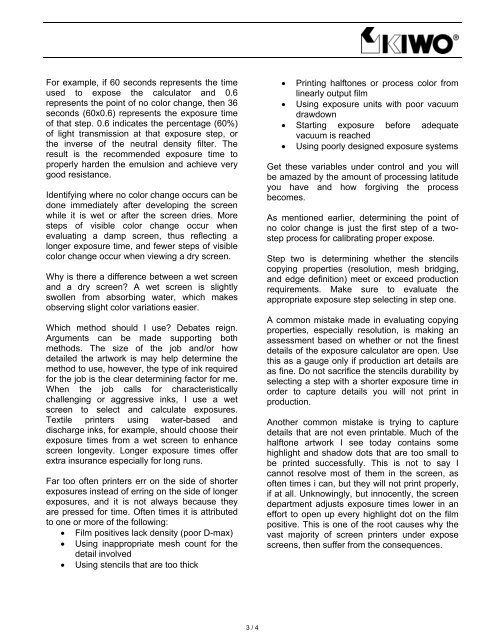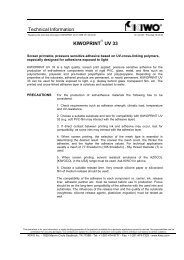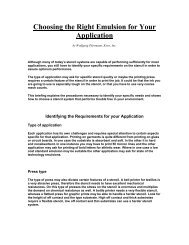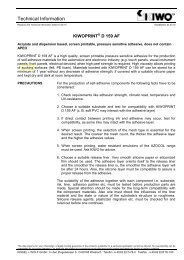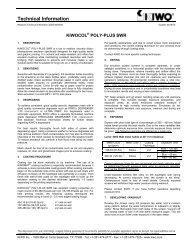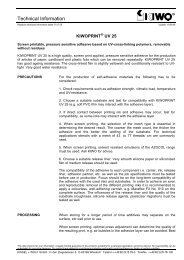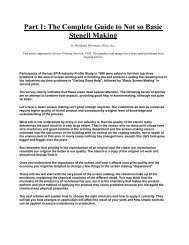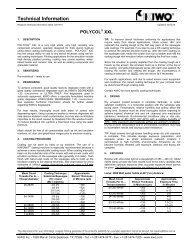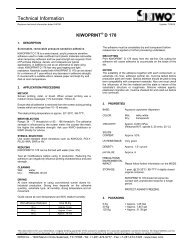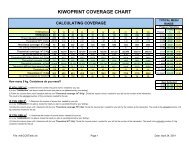Proper Exposure Calculation And the Compromise between ... - KIWO
Proper Exposure Calculation And the Compromise between ... - KIWO
Proper Exposure Calculation And the Compromise between ... - KIWO
Create successful ePaper yourself
Turn your PDF publications into a flip-book with our unique Google optimized e-Paper software.
For example, if 60 seconds represents <strong>the</strong> time<br />
used to expose <strong>the</strong> calculator and 0.6<br />
represents <strong>the</strong> point of no color change, <strong>the</strong>n 36<br />
seconds (60x0.6) represents <strong>the</strong> exposure time<br />
of that step. 0.6 indicates <strong>the</strong> percentage (60%)<br />
of light transmission at that exposure step, or<br />
<strong>the</strong> inverse of <strong>the</strong> neutral density filter. The<br />
result is <strong>the</strong> recommended exposure time to<br />
properly harden <strong>the</strong> emulsion and achieve very<br />
good resistance.<br />
Identifying where no color change occurs can be<br />
done immediately after developing <strong>the</strong> screen<br />
while it is wet or after <strong>the</strong> screen dries. More<br />
steps of visible color change occur when<br />
evaluating a damp screen, thus reflecting a<br />
longer exposure time, and fewer steps of visible<br />
color change occur when viewing a dry screen.<br />
Why is <strong>the</strong>re a difference <strong>between</strong> a wet screen<br />
and a dry screen A wet screen is slightly<br />
swollen from absorbing water, which makes<br />
observing slight color variations easier.<br />
Which method should I use Debates reign.<br />
Arguments can be made supporting both<br />
methods. The size of <strong>the</strong> job and/or how<br />
detailed <strong>the</strong> artwork is may help determine <strong>the</strong><br />
method to use, however, <strong>the</strong> type of ink required<br />
for <strong>the</strong> job is <strong>the</strong> clear determining factor for me.<br />
When <strong>the</strong> job calls for characteristically<br />
challenging or aggressive inks, I use a wet<br />
screen to select and calculate exposures.<br />
Textile printers using water-based and<br />
discharge inks, for example, should choose <strong>the</strong>ir<br />
exposure times from a wet screen to enhance<br />
screen longevity. Longer exposure times offer<br />
extra insurance especially for long runs.<br />
Far too often printers err on <strong>the</strong> side of shorter<br />
exposures instead of erring on <strong>the</strong> side of longer<br />
exposures, and it is not always because <strong>the</strong>y<br />
are pressed for time. Often times it is attributed<br />
to one or more of <strong>the</strong> following:<br />
• Film positives lack density (poor D-max)<br />
• Using inappropriate mesh count for <strong>the</strong><br />
detail involved<br />
• Using stencils that are too thick<br />
• Printing halftones or process color from<br />
linearly output film<br />
• Using exposure units with poor vacuum<br />
drawdown<br />
• Starting exposure before adequate<br />
vacuum is reached<br />
• Using poorly designed exposure systems<br />
Get <strong>the</strong>se variables under control and you will<br />
be amazed by <strong>the</strong> amount of processing latitude<br />
you have and how forgiving <strong>the</strong> process<br />
becomes.<br />
As mentioned earlier, determining <strong>the</strong> point of<br />
no color change is just <strong>the</strong> first step of a twostep<br />
process for calibrating proper expose.<br />
Step two is determining whe<strong>the</strong>r <strong>the</strong> stencils<br />
copying properties (resolution, mesh bridging,<br />
and edge definition) meet or exceed production<br />
requirements. Make sure to evaluate <strong>the</strong><br />
appropriate exposure step selecting in step one.<br />
A common mistake made in evaluating copying<br />
properties, especially resolution, is making an<br />
assessment based on whe<strong>the</strong>r or not <strong>the</strong> finest<br />
details of <strong>the</strong> exposure calculator are open. Use<br />
this as a gauge only if production art details are<br />
as fine. Do not sacrifice <strong>the</strong> stencils durability by<br />
selecting a step with a shorter exposure time in<br />
order to capture details you will not print in<br />
production.<br />
Ano<strong>the</strong>r common mistake is trying to capture<br />
details that are not even printable. Much of <strong>the</strong><br />
halftone artwork I see today contains some<br />
highlight and shadow dots that are too small to<br />
be printed successfully. This is not to say I<br />
cannot resolve most of <strong>the</strong>m in <strong>the</strong> screen, as<br />
often times i can, but <strong>the</strong>y will not print properly,<br />
if at all. Unknowingly, but innocently, <strong>the</strong> screen<br />
department adjusts exposure times lower in an<br />
effort to open up every highlight dot on <strong>the</strong> film<br />
positive. This is one of <strong>the</strong> root causes why <strong>the</strong><br />
vast majority of screen printers under expose<br />
screens, <strong>the</strong>n suffer from <strong>the</strong> consequences.<br />
3 / 4


